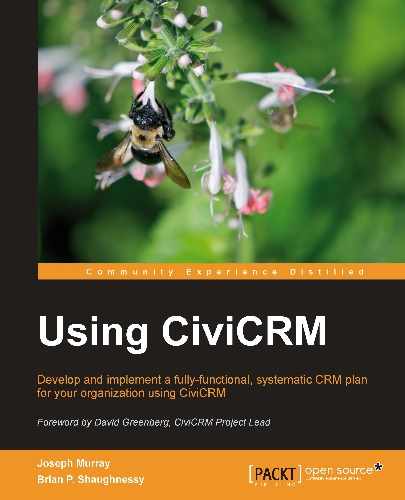We've mentioned a few times so far in this chapter the convenience of having groups constructed for sets of contacts that are regularly used for different purposes. Chapter 5, Collecting, Organizing, and Importing Data explained the difference between static and smart groups. With static groups, members are explicitly added or removed from the group either by an administrator (for example, for a Board of Directors group) or themselves (for example, for an opt-in mailing list). With smart or dynamic groups, search criteria define the group. As data associated with contacts changes, it may be added or removed from the group based on the defined criteria. A smart group might contain all contacts with memberships expiring in the next month, or those who have donated more than $2500 in total over the last two years.
One of the primary purposes of creating groups is to easily manage segments of records you are communicating with. One functional way to look at this is to think of the contacts that the communications staff will need to find and select repeatedly. If your communication efforts are oriented around regularly-disseminated products, such as a monthly newsletter, you will orient your groups around the list of contacts to which they are sent. Every one of those lists stored in CiviCRM is a good candidate for becoming a group.
Other parts of your organization may also be communicating with groups of constituents and will need their own CiviCRM groups. Volunteer management, development/fundraising, membership, education, or events will each need CiviCRM groups set up for every list they deal with.
Groups are also essential to CiviMail, CiviCRM's bulk e-mailing tool. We strongly recommend that bulk e-mails should only be sent to contacts who have opted-in to that specific mailing, which makes it essential that the membership in those lists be self-managed. In some jurisdictions, this is becoming the law. When generating smart groups from searches, you can easily accommodate the removal of opt-out contacts. Other forms of communication such as direct mail and telemarketing are also trending more towards permission-based models that at least allow for opt-outs.
There are two general rules of thumb on how to implement groups for communications in CiviCRM. First, it works well to use opt-in static groups for subscriptions to regular communication products like newsletters. These self-serve subscriptions are excellent at bringing people into the wide side of the funnel.
Second, it works well to use smart groups based on the segmentation criteria for targeting certain constituents for conversion efforts from one layer in the funnel to another. For example, high-touch, high-cost approaches for major donors should be directed towards members of a tightly qualified set of prospects.
To review whether a group is currently set up so that it can be used for e-mailing or so that people can see and control their membership in it, follow these steps:
- Click on Contacts | Manage Group.
- Under Group Type, review if the group is set up as a Mailing List. Only groups configured as a Mailing List will be visible to the CiviMail bulk e-mail interface.
- Under Visibility, review if the group is configured to appear on Public Pages. This visibility option determines if the group will appear in profile pages that include the group(s) field, and whether it will appear in the Mailing List Subscription page.
- If you want to change one of these parameters for an existing group, click on the Settings button towards the right of its row and make the desired changes.
Occasionally, it can be convenient to create a hierarchy of groups for communication purposes. For example, a chapter-based organization that manages newsletter subscriptions at the local level may have a central communication product that is sent to all subscribers of local subscriptions. If there were hundreds of local chapters, such as constituency associations in a political party, then it would be quite elegant to have each local newsletter subscriber group set up as a child of the central one if the opt-in messages indicated that both a central and local newsletter would be sent to subscribers. Users would be able to select a single list, and staff would not need to worry about lists getting out of sync.
When editing the settings for a group as just described, parent groups can be added one at a time by selecting them in the Add Parent field and clicking on Save. Similarly, parent groups can be deleted by selecting the group under Remove Parent and then clicking on Save.
